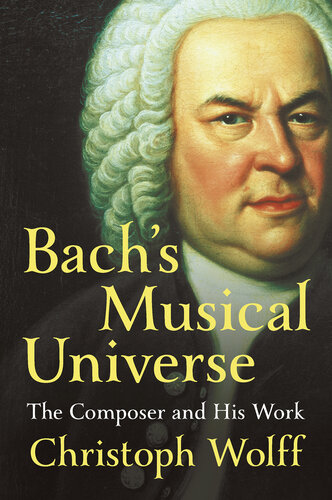
Bach's Musical Universe
The Composer and His Work
کتاب های مرتبط
- اطلاعات
- نقد و بررسی
- دیدگاه کاربران
نقد و بررسی

December 15, 2019
A close investigation of Bach's works reveals remarkable transformations. Eminent musicologist Wolff (Adams University Professor Emeritus/Harvard Univ.; Mozart at the Gateway to His Fortune: Serving the Emperor, 1788-1791, 2012, etc.) offers an erudite companion to his biography Johann Sebastian Bach (2000), a Pulitzer Prize finalist, with a detailed examination of the development of Bach's creative process, goals, and achievements. Because Bach left no theoretical writings, Wolff selects from the composer's prodigious oeuvre--including keyboard workbooks, toccatas, suites, sonatas, concertos, choral works, and oratorios--to focus on elements of musical design, engagement with other repertoires and genres, reassessment of existing conventions, and innovations. Facsimile pages are excerpted from an online library of Bach manuscripts. Bach, writes the author, "competed with himself constantly," making "judicious revisions to his own works." His competitive attitude also led him to pay careful attention to the works of other composers, past and contemporary, as he evaluated his own compositions. Also influencing his musical evolution were the demands of his changing professional duties: town organist, court organist and chamber musician, concertmaster, and cantor and music director in Leipzig, where he also directed the Leipzig Collegium Musicum for more than 10 years. As part of his duties in Leipzig, he was required to offer about 60 cantata performances yearly; although these did not have to be his own compositions, Bach added "a considerable repertoire of his own music" to his growing sacred and secular vocal compositions. Throughout his career, Wolff notes, Bach was "a passionate instrumentalist," acclaimed for his performances on the organ and harpsichord, and he was frequently invited to give guest concerts. His prowess on the keyboard fed directly into his "pathbreaking approaches" to harpsichord and fortepiano. The author identifies Bach's intense interest in exploring "all facets of the art of polyphony" as singularly characteristic of the composer's musical language. For a musically sophisticated reader familiar with Bach's works, as well as musical terminology and technique, Wolff's analyses have the potential of enriching the listening experience. An authoritative, lucid chronicle of Bach's multifaceted musical context.
COPYRIGHT(2019) Kirkus Reviews, ALL RIGHTS RESERVED.

December 23, 2019
The celebrated 18th-century German composer Johann Sebastian Bach was the great brainiac of classical music, according to this dense scholarly study. Harvard music historian Wolff (Johann Sebastian Bach: The Learned Musician) styles Bach a musical intellectual whose hallmarks were “swift mental processing of complex musical considerations” and “meticulous rationalizations of the creative act,” all bent toward perfecting the complex counterpoint of polyphonic voices that snake and twine through his music. This isn’t a full biography; instead, Wolff focuses on analyzing a group of landmark compositions, including the keyboard pieces in The Well-Tempered Clavier and the Goldberg Variations, the giant cycle of chorale cantatas for church services; the Brandenburg Concertos and the St. John and St. Matthew Passions. The book is quite technical and often bone dry as it delves into the details of compositional dating; issues of tuning, counterpoint, and instrumentation; the selection of texts for choral writing; and the revisions Bach made in pieces over the years. It’s full of music theory, tabularized data on the structures of compositions, and photos of Bach’s manuscript scores that convey little impression beyond how bewilderingly complicated they are. Readers with a serious musicological background will appreciate Wolff’s deep dive into Bach’s craft, but casual Bach-lovers will find it a heavy and not very tuneful slog.

February 14, 2020
For readers wishing to explore the universe that is the music of Johann Sebastian Bach (1685-1750), there's no better guide than scholar Wolff (former director, Bach Archive; Johann Sebastian Bach: The Learned Musician). The author trains a sharp eye on the composer's vast musical legacy, focusing on what he refers to as benchmark works, "all of them without parallel or equivalent," which "produced a steady stream of transformative musical ideas that were clearly intended to stand as paradigms of his musical art." Among the pieces featured are The Art of the Fugue, The Well-Tempered Clavier, and the Goldberg Variations. Discussions of each composition include historical and musical context and illustrative tables. Helpfully, the volume also offers a chronology, extensive notes, and a concise bibliography. VERDICT Students, musicians, and serious aficionados of Bach will be the most appreciative audience for this artfully composed work.--Carolyn M. Mulac, Chicago
Copyright 2020 Library Journal, LLC Used with permission.

February 15, 2020
Johann Sebastian Bach's colossal output makes it difficult for anyone to characterize his music. Wolff, Harvard professor and director of Leipzig's Bach Archive, knows the master's work both broadly and deeply, so he sets out to find the larger themes and organizing principles to help modern listeners understand what Bach accomplished during his career. Bach had to produce music almost daily to support the church year's liturgical cycle, but that scarcely stopped him from exploring the vast soundscape of polyphony that still serves as textbook examples of pure musical form for its own sake. And Bach was determined that this music be played in ways to avoid monotony. Thus, in his famous Goldberg Variations, the final section of the Clavier-�bung, Bach specified strict meters and tempos that give this music liveliness and even surprise. He also cast many pieces in ways that allowed them to be performed by both multi-keyboard instruments or less elaborate instrumentation. Wolff's work speaks to the musically adept, and his scholarly perspective requires more than passing familiarity with reading musical notation.(Reprinted with permission of Booklist, copyright 2020, American Library Association.)

























دیدگاه کاربران